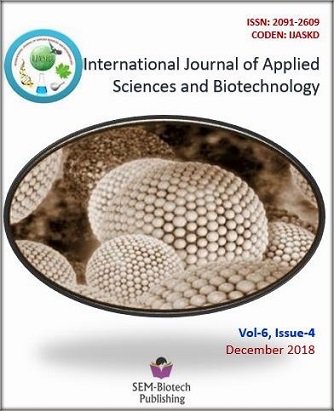Enhancement of Substrate Decomposition through Potential Hydrolytic Bacteria for Cumulative Biogas Production
DOI:
https://doi.org/10.3126/ijasbt.v6i4.22131Abstract
Scenarios focus on the practical behavior of anaerobic decomposition systems to enhance biogas production, in addition to assure economic progression and ecological sustainability. The present study has framed to identify the potential hydrolytic bacteria from five different sources since principally the efficacy of hydrolytic bacteria determines the rate of hydrolysis of anaerobic decomposition and thereby biogas production. Among the 40 dominant bacteria isolated from diverse bases, 10 isolates were selected as efficient through preliminary screening. Consequently, the premier enzyme activity obtained from the isolate G5 obtained from goat rumen fluid for cellulase (44.16±1.00 U/ml), protease (260.63±1.35 U/ml) and lipase (33.20 ± 0.81 U/ml). Morphological, biochemical and molecular characterization revealed that G5 is Bacillus sp. DDG5 (KM093856.1). A range of pH (7.0-7.5) and temperature (40oC) was sufficient for the highest activity of hydrolytic enzymes experienced. Biogas production using cow dung showed an improved efficiency of 9.54 % in Bacillus sp. DDG5 treated tank (70.16 ± 1.54 %) in contrast to control (58.13 ± 1.02%) at 30th day. However, this study established that Bacillus sp. DDG5 obtained from goat rumen fluid is the promising hydrolytic bacteria, since it can be applied for proficient hydrolysis of various organic materials to enhance methane production in outlook.
Int. J. Appl. Sci. Biotechnol. Vol 6(4): 386-396




